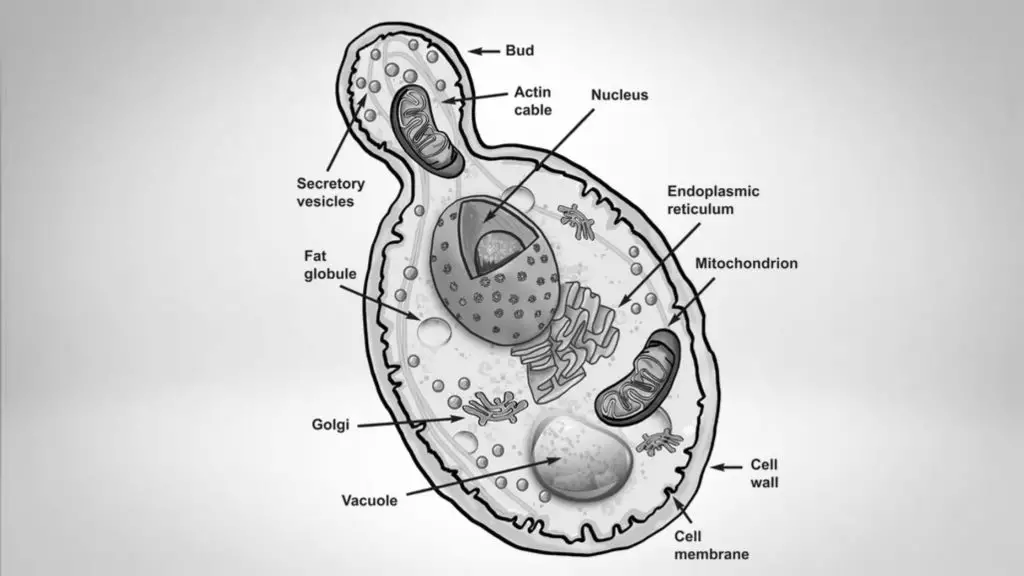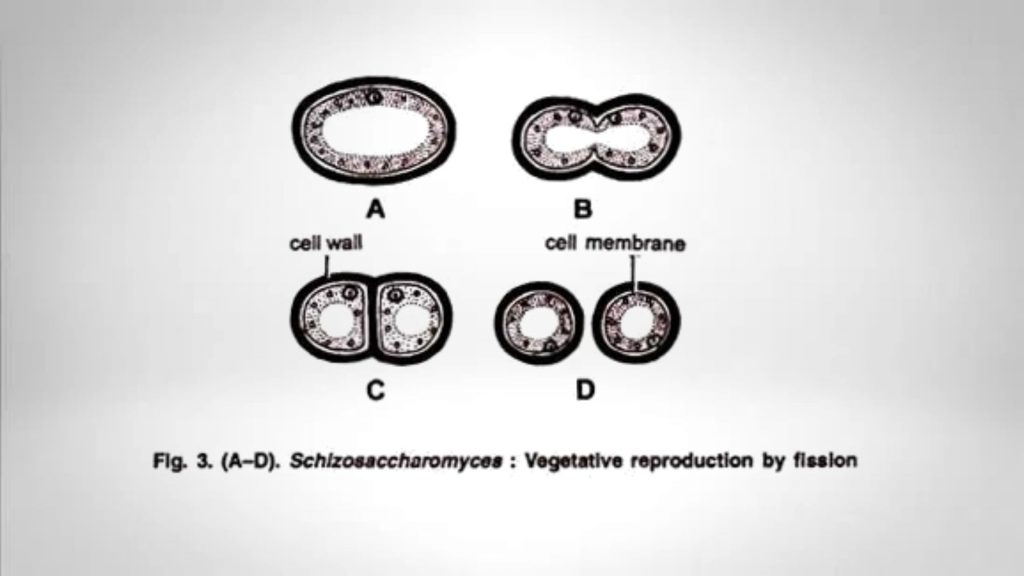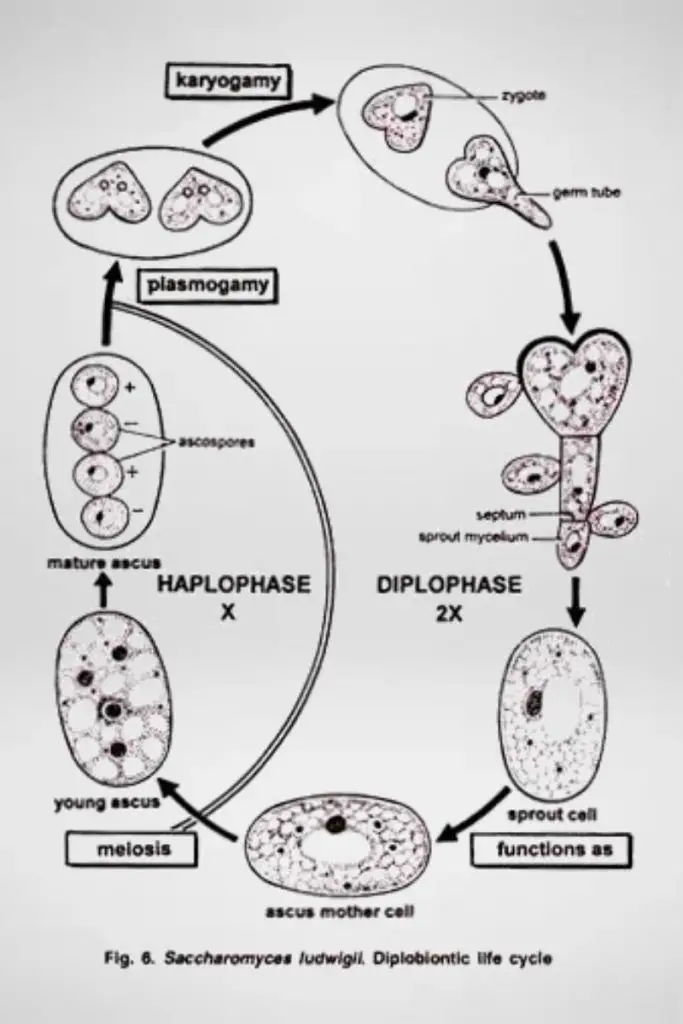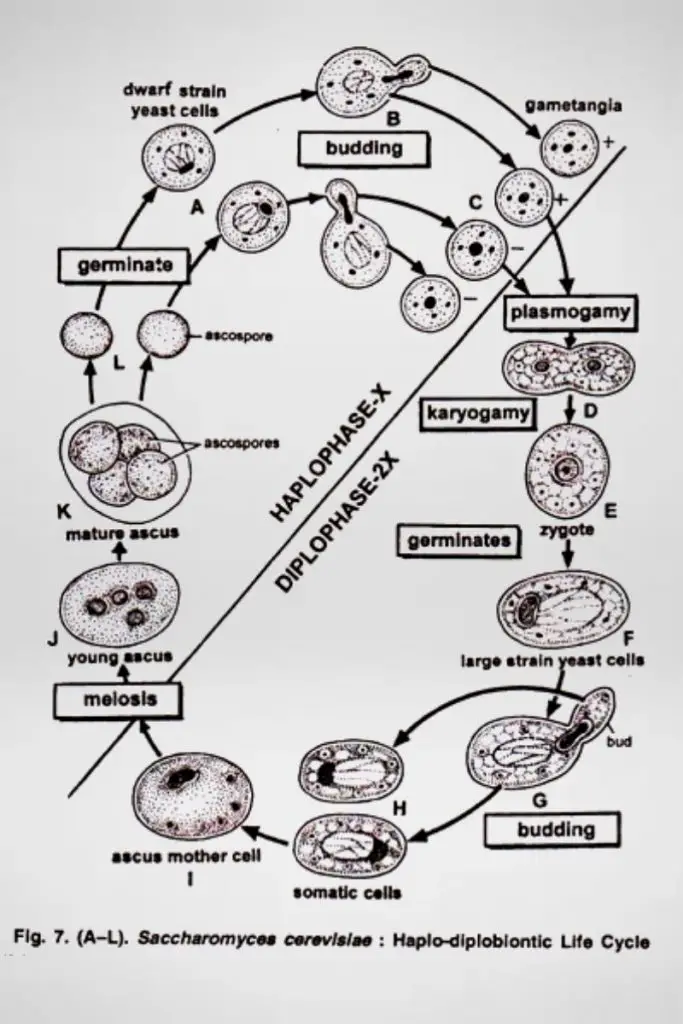| Kingdom | Fungi |
| Division | Ascomycota |
| Order | Saccharomycetales |
| Class | Saccharomycetes |
| Species | S. cerevisiae |
| Genus | Saccharomyces |
| Family | Saccharomycetaceae |
| Binomial name | Saccharomyces cerevisiae |
What is saccharomyces cerevisiae?
Yeast or Saccharomyces cerevisiae is a eukaryotic, unicellular microorganism and a member of the fungus kingdom. These are the unicellular microorganism which is evolved from multicellular ancestors. Some of them have the ability to show multicellular characteristics by forming pseudohyphae or false hyphae.
Morphology of Saccharomyces cerevisiae
- Yeast is a single-celled or unicellular fungus.
- These are eukaryotic cells.
- The size of yeast varies from 3 to 4 µm in diameter. Sometimes they can grow up to 40 µm in size. The variation in size depends on the environment and types of species.
- Most of them reproduce asexually by mitosis and many of them follow an asymmetric division process known as budding.
- Yeast is dimorphic in nature, which means it can exist in both a single cellular form and multicellular form.
- Yeast or Saccharomyces cerevisiae are egg-shaped, some of them are elongated or spherical shape.
- The size and shape of yeast vary based on the types of species.
- Flagella and others organs of locomotion are absent in yeast.
- The cell wall of yeast is made up of chitin.
- It contains a cell membrane which is surrounded the protoplasm. The protoplasm contain usual cell organelles like ribosomes, mitochondria, ER, nucleus and other granules
- The Vacuole of yeast is single, large and centrally located.
Nutrition and growth of Saccharomyces cerevisiae
- They are chemoorganotrophs, which means they don’t require any sunlight to grow, they can use organic compounds as a source of energy.
- They use hexose sugars, such as glucose and fructose, or disaccharides (sucrose and maltose) as a source of carbon.
- Most of them grow in neutral or slightly acidic pH environments.
- The growing temperature or optimum temperature of yeast vary such as Leucosporidium frigidum grows at −2 to 20 °C (28 to 68 °F), Saccharomyces telluris at 5 to 35 °C (41 to 95 °F), and Candida slooffi at 28 to 45 °C (82 to 113 °F).
- In laboratory, they can grow on solid growth media or in liquid broths. Some example of common media is Wallerstein Laboratories nutrient agar, potato dextrose agar or potato dextrose broth, yeast peptone dextrose agar, and yeast mould agar or broth.
Habitat of Saccharomyces cerevisiae
- Yeast mainly grows on sugar-rich materials.
- They can be found on surfaces of fruits and berries (such as grapes, apples, or peaches), and exudates from plants (such as plant saps or cacti).
- They also found in soil and in association with insects.
- They can be found in gut flora of mammals and some insects as well as in deep-sea environments that host an array of yeasts.
Economic Importance of Saccharomyces cerevisiae
- Alcoholic beverages: Yeast is used in industries for the production of different types of beverages that contain ethanol (C2H5OH) such as mead, wine, beer, or distilled spirits.
- Baking: S. cerevisiae is used in baking as a leavening agent which converts the food/fermentable sugars existing in the dough into carbon dioxide.
- Bioremediation: Yeast also used in bioremediation, for example, Yarrowia lipolytica, is knowing as yeast which can degrade palm oil mill effluent, TNT, and other hydrocarbons, such as alkanes, fatty acids, fats, and oils.
- Industrial ethanol production: Yeast can convert sugar into ethanol, for this ability, it is used in the biotechnology industry for the production of ethanol fuel.
- Nonalcoholic beverages: Yeast also used for the production of Nonalcoholic beverages, these are sweet carbonated beverages. These contain carbon dioxide, trace amounts of alcohol, and a very low amount of residual sugar in the drink. Some examples are Root beer, Kvass, Kombucha, Mauby, Kefir, and kumis.
- Nutritional supplements: It is also used as nutritional supplements, that’s why it is also known as “nutritional yeast”. A deactivated S. cerevisiae. Or yeast is used as a Nutritional yeast. It contains low fat and sodium and a source of protein and vitamins, particularly most B-complex vitamins, as well as other minerals and cofactors needed for growth.
- Probiotics: S. boulardii is used as a probiotic to sustain and reestablish the natural flora in the gastrointestinal tract.
- Aquarium hobby: Yeast sometimes is used by aquarium hobbyists to produce carbon dioxide (CO2) to feed plants in planted aquaria.
- Yeast extract: Yeast extract is the general term for different forms of processed yeast goods that are utilized as food additives or flavors.
- Scientific research: S. cerevisiae, S. pombe, and some other species of yeast are used in genetics and cell biology, largely because they are simple eukaryotic cells. They serve as a model of the eukaryotic cells for the study of the cell cycle, DNA replication, recombination, cell division, and metabolism.
- Genetically engineered biofactories: Various species of yeasts are used in Genetically engineered biofactories to produce various drugs, this technique is known as metabolic engineering.
Pathogenic Saccharomyces
- Some species of yeast act as an opportunistic pathogen, which can cause disease in an individual with compromised immune systems. Cryptococcus neoformans and Cryptococcus gattii is an example of opportunistic pathogen which cause cryptococcosis in immunocompromised people.
- Candida cause oral and vaginal infections in humans which is known as candidiasis.
Vegetative Structure of Saccharomyces cerevisiae
The yeast cell was first described by Antony Von Leeuwenhoek. It is a thallus body that is unicellular and non-mycelial. During the budding, they rarely produce pseudo mycelium. The cells are remain attached during the budding process and form a chain-like structure which is known as pseudo- mycelium.
The unique cells are polymorphic means show distinct shapes, even if they grow in the same culture, based on the nutrition available.
A yeast cell can be circular, spherical, oval, elliptical, elongated, rectangular, dumb-bell shaped to triangular. Teh size ranges from 2 to 8 µ in diameter and 3 to 15 µ in length.
The cells are colorless but the colonies appear white, cream-colored or light brown. The cells contain a protoplast which is surrounded by a definite cell wall.

The Cell Wall
- The yeast cell contains a three-layer cell wall that is thin, delicate, and flexible.
- This cell wall is made up of polysaccharides such as mannan (30%) and glucan (30-40%) with smaller amounts of protein (6-8%), lipid (8.5 – 10-5%), and chitin (2%). Cellulose is absent.
- The outer layer is made up of protein-mannan and some chitin
- The middle layer is made up of glucan.
- The innermost layer is made up of proteinglucan.
- Some cell walls also contains phosphate and lipids.
- They lack cellulose in their cell wall.
The Protoplast
- Yeast also contains a cytoplasmic membrane or plasma membrane at the inner side of cell wall. This plasma membrane surrounded the cytoplasm and a nucleus.
- At the center, it contains a vacuole covered by a single membrane, and tonoplast, which carries a watery substance, granules of polymetaphosphate and lipid.
- The cytoplasm contains various organelles such as the nucleus, mitochondria, Golgi apparatus, endoplasmic reticulum, ribosome, and other substances like glycogen bodies, volutin granules, oil globules etc.
- It also contain several hydrolytic enzymes such as proteases, esterases, ribonuclease etc.
- The nucleus contains a pours nuclear membrane and
Saccharomyces cerevisiae Reproduction
Yeast reproduces by different methods such as vegetative, asexual and sexual methods.
Vegetative Reproduction of Saccharomyces cerevisiae
The vegetative reproduction in yeast takes place by two methods such as;
Budding
Most of the yeast follows the budding method for reproduction in the presence of favorable environmental conditions.
- In this method, a bud or outgrowth is formed on the parent cell surface.
- Now the bud is started to enlarge, meanwhile the parent nucleus is started to divide.
- The mitochondria and one daughter nucleus is started to migrate from mother cell to bud.
- A transverse septum is formed between the bud and mother cell as a result the bud got separated from the mother cell.
- Now the separated bud give rise to a new daughter cell.
- On separation, the bud leaves behind a bud scar.
- Often buds are not get separated from the mother cell, hence they form more buds as result it leads to branched or un-branched chains which look like a short hypha. This chain-like structure is known as esudomycelium.

Fission
Yeast sometimes terms as fission yeasts because some of them reproduce by fission processes such as Schizosaccharomyces octosporus.
- The fission of yeast cell is accomplished by transverse division. In this method, the yeast cell is first elongated.
- Then, the nucleus started to divide and a transverse wall (septum) is developing centripetally (from the periphery towards the center, thus departing the two daughter uninucleate cells).
- Finally, the transverse wall thickens and as a result, it separates the two daughter cells.

Asexual Reproduction of Saccharomyces cerevisiae
- The mainly unfavorable condition triggers the Asexual Reproduction of Yeast, during the time it leads to the formation of a thick-walled spore, known as endospore.
- During asexual reproduction, the nucleus of yeast cells divides mitotically and develops four nuclei.
- Cytoplasm gets around the nucleus and each forms a thick wall.
- This structure is known as an endospore. In return for favorable conditions endospores are again giving rise to new yeast cells.
Sexual Reproduction of Saccharomyces cerevisiae
The un-favorable condition triggers the sexual reproduction of yeast. In this method, two vegetative cells or ascospores act as gametangia, which are come in close contact and develop beak-like projection towards each other. Both the outgrowths come in contact and the intervening walls between them dissolve.
The nuclei of both the gametangia come within the outgrowth (through conjugation tube) and they fuse to develop a diploid zygote. This zygote acts as an ascus.
Now, this newly formed diploid nucleus of the zygote follows the meiotic division to form 4 or 8 (with additional mitosis) ascospores. Finally, the ascospores are liberated by breaking the ascus wall and act as a somatic cell.
Saccharomyces Life Cycle
The cell show three types of life cycel such as;
- Haplobiontic life cycle, found in Schizosaccharomyces octosporus.
- Diplobiontic life cycle, found in Saccharomycodes ludwigii.
- Haplo-diplobiontic life cycle, found in Saccharomyces cerevisiae.
Haplobiontic life cycle
- Schizosaccharomyces octosporus cells are haploid and the diploid (2x) phase is very short in the life cycle.
- The zygotic cell represents the diploid phase in the Haplobiontic life cycle.
- These cells are uninucleate, elongated, homothallic, and function as gametangium during maturity.
- Two cells are come in contact and formed a conjugation tube. Now the cell’s nucleus and migrate into the conjugation tube and fuse to form the zygote (diploid phase).
- It directly acts as an ascus mother cell. The nucleus of the zygote follows the meiotic division to form eight haploid nuclei. Meantime, the conjugation bridge expandsand the entire structure and becomes barrel-shaped and is termed as an ascus. Therefore, the parent cells immediately converted into the ascus.
- Now, Cytoplasm accumulates around the nucleus and each of them forms into an ascospore. Therefore, eight haploid ascospores are produced within the ascus.
- These haploid ascosporesares are released by rupture the ascus wall. These ascospores act as self-governing somatic cells.
- These are expanded and form daughter cells by fission.
- The haplobiontic life cycle is found in Schizosaccharomyces octosporus.

Diplobiontic life cycle
- Saccharomycodes ludwigii cells are diploid (2x), and haploid (x) phase is represented only by the ascospores ultimately expands to act as an ascus.
- During the process of sexual reproduction, the diploid nucleus splits meiotically to form 4 haploid ascospores.
- The 2 nearby ascospores of different mating type (‘+’ and ‘-‘) fuse (plasmogamy and karyogamy) inside the ascus and develop a diploid cell.
- Therefore, the ascospores undeviatingly act as gametangia and two diploid cells are generated inside the ascus.
- The zygote germinates in situ forming tubular outgrowth or germ tube. It penetrates its way within the ascus wall and acts as sprout mycelium and creates diploid yeast cells by budding.
- These buds are departed from the parent cells and repeat the process.

Haplo-diplobiontic life cycle
- The yeast cell also shows the Haplo-Diplobiontic Life Cycle, where the duration of both haploid (x) and diploid (2x) phases are long because both the haploid and diploid cells are multiply by the budding process.
- S. cerevisiae contains two types of somatic cells such as ‘Dwarf strain’ and ‘large strain’ cells.
Dwarf strain
- In the haploid stage, the cells are tiny, spherical, and relate to two mating types (‘+’ and “-‘) strains. Because of their small size, they are termed as ‘Dwarf strain’ yeast cells.
- The haploid cells act as gametangia. They come in close contact and ultimately the gametes of ‘+’ and ‘-‘ strain fuse to develop a dikaryon (Plasmogamy).
- The two nuclei are fuse this process is known as karyogamy and the diploid fusion nucleus is termed as a synkaryon, and the cell carrying it is known as a zygote.
Large strain Cells
- The large zygote lives like vegetative cells. This cell multiplies by following the budding proces.
- The produced cells in budding processes are diploid, ellipsoidal and larger in size than the ‘dwarf strain’ cells.
- Large strain Cells represent the diploid stage in the life cycle.
- In presence of suitable conditions, they double the number of diploid somatic cells of ‘large strain’ of yeast by following the budding process.
- In unfavorable situations, the diploid cell immediately act as an ascus parent cell and its nucleus splits mitotically to create 4 ascospores. Two of these are of ‘+’ strain and the other two are of ‘-‘ strain.
- On returning to suitable situations the ascospores are released by breaking of ascus wall.
- Each globose shape ascospores is germinated into a minute somatic cell of ‘dwarf strain’. These cells are double by budding to raise the number of haploid phases, therefore achieving the life cycle.

Yeast also follow other methods of Copulation
Adelphogamy
In Schizosaccharomyces mellacei and S. pombe the copulation occurs among two adjoining sister cells. This is isogamous and the cells dedicated to copulate do not separate after ‘fission’ but combine to develop short chains.
Pedogamy
In some yeast (i.e. Debaromyces, Nadsotiia), copulation occurs between the mother and the daughter cells which are produced by ‘budding’. This is an anisogamous type of copulation in which the minute daughter cell acts as the male and the large parent cell behaves as the receiving cell.
Parthenogamy
Parthenogamy is found in species of Zygosaccharomyces, Saccharomyces, and Schizosaccharomyces where asci are developed without any copulation.
- Text Highlighting: Select any text in the post content to highlight it
- Text Annotation: Select text and add comments with annotations
- Comment Management: Edit or delete your own comments
- Highlight Management: Remove your own highlights
How to use: Simply select any text in the post content above, and you'll see annotation options. Login here or create an account to get started.